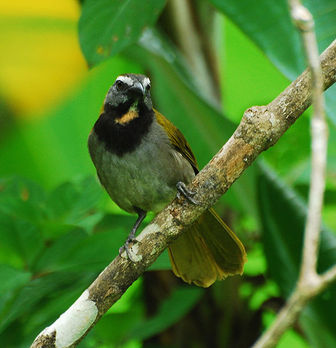Buff-throated Saltator
This is the type species of Saltator. Consequently, it and its closest allies would retain the genus name when this apparently polyphyletic group is eventually split up.

Original source: Jerry OldenettelPermission(Reusing this file)This image, which was originally posted to Flickr.com, was uploaded to Commons using Flickr upload bot on 18:49, 14 April 2008 (UTC) by Ltshears (talk). On that date it was licensed under the license below. This file is licensed under the Creative Commons Attribution-Share Alike 2.0 Generic license.You are free:to share – to copy, distribute and transmit the work
Author: Jerry OldenettelPermission(Reusing this file)This image, which was originally posted to Flickr.com, was uploaded to Commons using Flickr upload bot on 18:49, 14 April 2008 (UTC) by Ltshears (talk). On that date it was licensed under the license below. This file is licensed under the Creative Commons Attribution-Share Alike 2.0 Generic license.You are free:to share – to copy, distribute and transmit the work
The Buff-throated Saltator is classified as Least Concern. Does not qualify for a more at risk category. Widespread and abundant taxa are included in this category.
spotted a Buff-throated Saltator feeding high up in a tree with a host of other birds and, to be frank, I didn’t look at it as closely as I ought to have (there were just so many species to see). I know I didn’t look carefully enough because on our last full day of the festival, while wandering the hotel grounds, I came across a whole flock of the species and failed to identify them. More
The Buff-throated saltator can be found in lighter woodland, forest borders and shrubby clearings. Distribution This species has been reported from southeastern Mexico to northern Bolivia and southern Brazil. Natural History Notes The Buff-throated saltator will be usually found alone or in pairs, hidden in the dense foliage. It feeds on seeds, buds and nectar. Conservation status according to IUCN 2008 Red list: Least Concern (LC). More
Buff-throated Saltator, the genus' type species (which would retain the genus name), it resembles the probably well distant Black-throated Saltator or even the Golden-billed Saltator in other aspects. This bird is on average 24 cm long and weighs 85 g. The adult has a slate-grey head with a whitish supercilium. The upperparts are yellowish green, the underparts are pale grey, and the throat is white edged with black. The thick convex bill is black and the legs are brown. More
The Buff-throated Saltator, Saltator maximus, is a seedeating bird. Traditionally placed in the cardinal family (Cardinalidae), it actually seems to be closer to the tanagers (Thraupidae). It breeds from southeastern Mexico to western Ecuador and northeastern Brazil. This is the type species of Saltator. Consequently, it and its closest allies would retain the genus name when this apparently polyphyletic group is eventually split up. The Buff-throated Saltator is on average 20 cm long and weighs 42-52 g. More
Buff-throated Saltator was illustrated. The first time I saw the species I was not sure if it was Buff-throated or Grayish Saltator. Here you have both species. More
This species is similar to the Buff-throated Saltator, but is larger and has a darker head and paler underparts. Call / Vocalization: The common call is a raucous deeeer. The song is a loud scratchy cher cher jur jur weeee, often given by males as a duet. Diet Feeding: The Black-headed Saltator feeds on fruit, buds, nectar and slow-moving insects. More
Buff-throated Saltator is on average 20 cm long and weighs 42-52 g. The adult has a slate-grey head with a white supercilium and a greenish crown. The upperparts are olive green, the underparts are grey becoming buff on the lower belly, and the throat is buff, edged with black. The thick convex bill and legs are black. Young birds are duller, and have a white-mottled blackish throat and breast, and brown markings on the lower underparts. See more at Wikipedia.org... More
For the purposes of our bird news services, Buff-throated Saltator is classed as ungraded: species which are unlikely to appear as wild birds in Britain or Ireland (Note that rarity levels are currently applied nationally and may not reflect local variations in abundance. More
Buff-throated saltator, Wilson Botanical Gardens, Organization for tropical studies, near san Vito, costa Rice, near the Panama border. Buff-throated saltator KAC0162.jpg 43 of 217previous next Buff-throated saltator, Wilson Botanical Gardens, Organization for tropical studies, near san Vito, costa Rice, near the Panama border. Copyright Kathy Adams Clark/KAC Productions, P O Box 8674, The Woodlands, TX 77387, 281-367-2042, kathyadamsclark@Comcast. More
Buff-throated saltatorBirds in Suriname = - Buff-throated saltator Photo of a Buff-throated Saltator made by Carl Beel made in December 2009 in Suriname and a second one by J.S. Dunning, made in Colombia. Otte Ottema made a recording of the sweet whistling song of a Buff-throated saltator in the Bakhuis area in April 2006. It eats mainly fruit and flowers and is easier heard than seen. More
The buff-throated saltator has a strong beak, slightly convex at the tip. Its face is grey. Its throat is white toward the top and buff toward the bottom, with a black ring. The top of the head, wings and tail, and its back, are olive green. Reproduction These birds build their nests from 25 cm to 2 m above the ground, more rarely up to 9 m, in the dense foliage of trees and shrubs. More
Family : Cardinalidae
Genus : Saltator
Species : maximus
Authority : (Müller, 1776)
